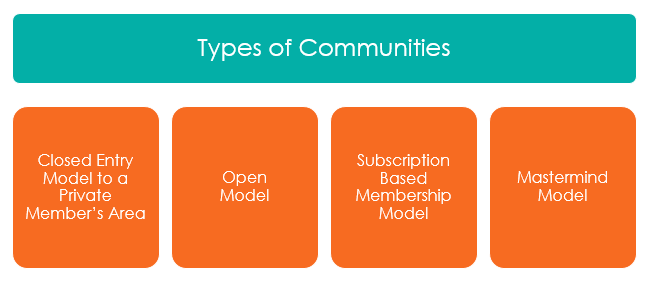Welcome to
Build the Brand then the CommunityGetting your community to know, like and trust you
Your Business Goals
Having a community of loyal fans sounds great, but you need to make sure that the time and effort you spend creating and maintaining it will bring you the results you want. This means that your community activities must be in line with your wider business goals.
It’s a good idea to get clear on those goals before you start your community, rather than later after you’ve already put in time and effort to build it. For example, say your goal is to cut customer support tickets by 10% in the coming year because you are spending too much time and money dealing with them. There are several ways to tackle this, but you think that starting a brand community would help. You could monitor the discussion in your group and spot recurring customer service issues. You could then take action to prevent these issues from turning into support tickets.
Your goals for your community will be reflected in the benefits you discovered in the last module when you defined the pros and cons for your business.
Goals should be as specific as possible so that you can measure when you’ve attained them.
Your goal could be that your community will enable you to:
- Grow your email subscriber list to 1,000
- Ensure you give the best customer support package to purchasers that you can, resulting in zero complaints
- Increase your sales by 10% this financial year by selling to community members
- Get referrals leading to new business worth 10k in the next 3 months
You may choose to invest financially in your community. If so, one of your goals should be return on investment. Starting a community doesn’t require a huge investment unless you want it to. Potential costs include subscriptions to community platforms, small-scale advertising on social media, outsourcing graphic design, and so on. Where you allocate your budget will depend on your specific goals.
Revisit your business goals and consider the following questions:

- What are your specific goals for your community?
- How will your community help you achieve your overall business goals?
- What budget do you have for a community, if any?
Choose Your Community Model
There are a number of different types of communities out there. You might be familiar with some if you’ve belonged to a community yourself in the past.
Most brand communities are either wholly or primarily online. This is because with the Internet, you can attract interest from all over the world. Some online communities also offer offline activities which we’ll look closer at in a later module.
Let’s look at the most common types of communities:

- Closed entry model to a private member’s area – you have to apply and sign up to join the group and membership might be limited to a certain number of people or type of person
- Open model – anyone can take part in the group’s activities and everyone is welcome
- Subscription-based membership model – members pay a certain amount in regular intervals to belong to the community and benefit from its activities. It’s an ongoing group and people can opt out when they choose
- Mastermind model – the group is formed around a specific activity. It’s common in coaching and training businesses where the activity is focused on learning about a particular topic. The time of membership is often limited to a specific period to meet the objectives of the group, for example 12 months.
You need to decide whether a free or paid group will work best for you. You could choose to start with a more general free group and then move to a specific paid group offering exclusive content and other advantages once you’ve built a following.
The choice of your community will depend on your business goals.
Promote a Clear Brand Message
Your brand message is a combination of all aspects of your branding. It’s the synthesis of what you and your business is all about. It’s what you write on your web pages and convey through your sales copy. It’s crucial to your brand community.
Your brand message also promotes your unique value, which is the promise you make to your customers. It’s your chance to position yourself in the marketplace and set yourself apart from the competition.
Get clear on what your unique value is before you go any further.
Your brand message also conveys the benefits of your offering in a deeper sense. For example, a restaurant provides food, but it may brand itself as a fun place that brings the family together. An online platform provider which is technically advanced may emphasize how it puts its users in touch with a global audience. A hair salon may cut your hair well, but might claim to make you feel the best you’ve ever felt.
Here are a few examples:
- You’re a realtor with many years of experience. You spend a lot of time giving advice to people about how to enter the real estate investment market. You are happy to share your experience but one of your goals for this year is to cut down on this ‘unproductive’ time. You also want to test out ideas you have for a training program but you’re not sure what people are looking for. You decide to set up a closed entry community which will be free and hosted in the private member’s area of a social media platform. This way, you can help others starting out in real estate investing, while testing the water for your program idea.
- You are a coach providing a 6-month intensive, premium-priced package for business development. Your goals are to leverage your time better and increase your income. You decide to start an exclusive mastermind group for a small number of people. This community will meet online once a month and have access to bonus material through an online platform and communicate through a private forum.
Your Role in The Group
Before your start building your community, you need to decide what role you’re going to play in the group.
Any group, especially one with a substantial online element, will need a leader and a moderator.
The leader drives the group and gives it its direction — at the start, that’s going to be you. You have the responsibility for both the community goals and the value that people get from it. You decide on the budget and monitor it, as well as what content will be provided, what schedule to follow, and any other strategic questions.
But you’re also a participant in the community. You need to be visible and active. This could mean creating a welcome video for new members, popping in to do a weekly live video, answering questions for a couple of hours on a post once a week, etc. You decide how much time you can commit and what your members need from you as the leader.
The moderator is the day-to-day manager of the community. You may wish to take this role on as well, especially in the beginning stages of building your community. This involves ensuring that the group guidelines are followed, adding new members, monitoring comments and questions, providing answers where possible (or involving someone else if necessary), helping new members get used to the group, adding content, etc.
Moderating means committing to spending a certain amount of time in the community every day, and you may not have this kind of time to give. In which case, you can find someone else to be the moderator. We’ll look at how you can do that in a later module, as well as different ways to manage the group. For now, you need to decide on the role you will play. Will you be the leader and also the moderator?
Answer these questions to help you decide:

- How will the role of a) leader and b) moderator fit with your other business goals?
- How much time can you give to the community? Do you have the amount of time you need to fulfill your chosen role?
- Will you use someone else as moderator? Who?
Key Takeaways:
- Your community activity must be in line with your wider business goals.
Action Steps:
- Determine the business goals for your community using the table in your Action Guide.
- Write down your specific community goals./li>
- Choose the community model that best suits your business.
- Decide on your role in your community. Answer these questions:
a) How will the role of leader and moderator fit with your other business goals?
b) How much time can you give to the community? Do you have the amount of time you need to fulfill your chosen role?
c) Will you use someone else as moderator? If so, who?
Cracking the Rich Code
"Whether you’ve been stuck on the sidelines waiting for the “right time” to launch your business or struggling to “generate” the life changing results from your business- This is your time to start saying “YES” to opportunity and “NO” to the noise. 100% of us entrepreneurs need answers and solutions. Join me to get updated on what it takes to prepare yourself and stay ahead of this changing business world."



